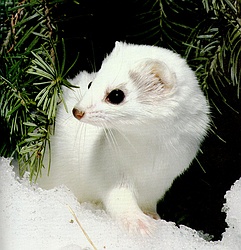
At first glance, it looked surreal, even improbable: A flash of white so pure it made the falling snow appear dirty. The sleek creature flitted through the sagebrush before offering a good look, but suddenly it reappeared only feet away: An ermine.
"Ermine" is the name given to the white phase of the short-tailed weasel. Common throughout North America, weasels are nevertheless difficult to spot. They never exist at high population densities, and rarely reveal themselves to humans. Seeing one in the white winter phase is a rare treat, something I had never seen before.
Short- and long-tailed weasels turn white in latitutdes where they are likely to get snow. This is a genetic trait: Move a southern weasel to Canada and it still remains brown.
While difficult to spot, the ermine is hardly shy around humans. Indeed, this one spent ten minutes circling around my friend and I, often coming within five feet of us for a close inspection. Its silky white coat contrasted with a brilliant black tip on its tail, and two beady black eyes. I suspect it was a "once in a lifetime" sighting.
I spotted this interesting little creature recently was in a wild stretch of land off the Owyhee Backcountry Byway. The area is grazed by cattle but I have rarely seen other visitors to this favorite spot.
At one time, the "sagebrush sea" that covers much of southern Idaho was considered monotonous and barren. But anyone who takes the time to explore sagebrush country knows that it is rich in wildlife. Nearly every visit to the Owyhees brings a new sighting, something unexpected.
That's why The Nature Conservancy is working to protect healthy sagebrush across southern Idaho, including in five-million acre
Owyhee County. By working together, we can protect this special place so that future generations can encounter the amazing wild country and interesting wildlife--like the ermine--that is found in the southwestern corner of Idaho.


